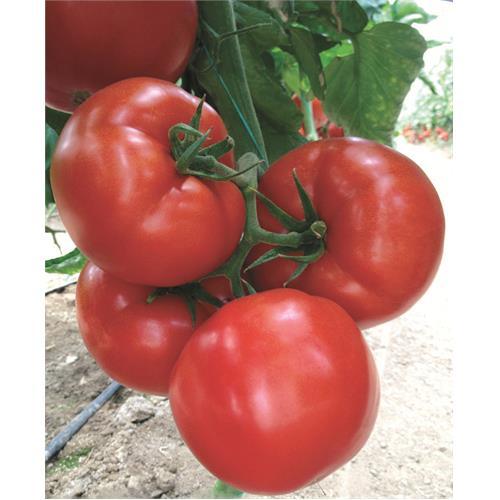
Power By MNASATI
Amazing Seeds - Channakali Tomato F1 / GANIYY Çanakkale Tarla Tomatoes F1

Seed sowing If the seedling growing material is annealed, there is no need for irrigation. Otherwise, seedling bags or seedling growing containers filled with seedling growing material need to be well watered and then seed sown. Planting the seeds after soaking for 3-4 hours facilitates germination. Seeds should be sown at an average depth of 1 cm. It is beneficial to water it lightly again after planting the seed. Planting is usually about 7-8 weeks after seed planting. In other words, if the last frost threat at your location is the 15th of April, count backwards 7-8 weeks and you can start planting seeds from the date you get them. The optimum soil temperature for the germination of seeds should be 12-15 degrees. At these temperatures, seeds germinate in 5-13 days. The best time to transplant tomato seedlings is when the cotyledon leaves have completed their full development and are parallel to the ground. Healthy and fully developed seedlings should be surprised. How is it germinated? Generally, mixtures such as (peat, perlite, vermiculite) or (peat, perlite, soil) or (burnt animal manure, sand, soil) are used in seedling cultivation. 1:1:1 ratio is used in the mixture of burnt animal manure, sand and soil. 2:1:1 ratio is used in peat, perlite, soil mixture. Seedlings are planted when the danger of spring frost is completely removed and the soil and air temperature reaches 12-15 degrees. Planting is usually about 7-8 weeks after seed planting. Planting should be done towards evening, seedlings should not be kept under the sun. When the seedlings are about 15-20 cm tall, they are usually ready for planting. Sufficient water should be given in planting. In tomato cultivation, the spacing between rows and above varies depending on whether the variety is pole or ground variety. Row spacing should be 60-80 cm in pole varieties, 50-60 cm in rows, 140 cm between rows in seat varieties, and 40-50 cm above rows. In other words, let's say you planted tomato seedlings on a single line. The distance between each seedling on this line should be 40-50 cm. If you are going to plant another row of tomatoes next to it, there should be 140 cm between this new line and the first line you planted. However, if you are going to do active maintenance such as regular fertilization and drip irrigation, you can shorten these distances. Care and other information Tomatoes love moisture. In the absence of water, the upper leaves curl. In very moist, heavy soils, the plants get sick. The periods when soil moisture deficiency is most sensitive are; germination, emergence, flowering and fruit formation periods. Excess soil moisture accelerates vegetative growth. Irrigation should not be done until the fruits are walnut-sized, unless necessary. In the next period, irrigation should be done 2-3 times in rainy regions and 4-5 times in arid regions. Tomato care The first hoe is done 2 weeks after the seedlings are planted. 2-3 weeks after I. anchor II. anchor is made. In this period, when the plants get 30-35 cm in height, in pole varieties II. The pole is also sewn together with the anchor. In inverted tomatoes (seat types do not want to be pruned in this way.) seat pruning is done. Removing the shoots formed at the junction of the trunk and the main leaves is called axilla. Tomatoes have a high demand for fertilizer. Tomatoes grown in soil supplemented with slow-release compost manure, pelleted fertilizers and organic fertilizers yield a bountiful harvest. Excess soil moisture accelerates vegetative growth. Irrigation should not be done until the fruits are walnut-sized, unless necessary. In the next period, irrigation should be done 2-3 times in rainy regions and 4-5 times in arid regions. Tomato care The first hoe is done 2 weeks after the seedlings are planted. 2-3 weeks after I. anchor II. anchor is made. In this period, when the plants get 30-35 cm in height, in pole varieties II. The pole is also sewn together with the anchor. In inverted tomatoes (seat types do not want to be pruned in this way.) seat pruning is done. Removing the shoots formed at the junction of the trunk and the main leaves is called axilla. Tomatoes have a high demand for fertilizer. Tomatoes grown in soil supplemented with slow-release compost manure, pelleted fertilizers and organic fertilizers yield a bountiful harvest. Excess soil moisture accelerates vegetative growth. Irrigation should not be done until the fruits are walnut-sized, unless necessary. In the next period, irrigation should be done 2-3 times in rainy regions and 4-5 times in arid regions. Tomato care The first hoe is done 2 weeks after the seedlings are planted. 2-3 weeks after I. anchor II. anchor is made. In this period, when the plants get 30-35 cm in height, in pole varieties II. The pole is also sewn together with the anchor. In inverted tomatoes (seat types do not want to be pruned in this way.) seat pruning is done. Removing the shoots formed at the junction of the trunk and the main leaves is called axilla. Tomatoes have a high demand for fertilizer. Tomatoes grown in soil supplemented with slow-release compost manure, pelleted fertilizers and organic fertilizers yield a bountiful harvest. Irrigation should not be done until the fruits are walnut-sized, unless necessary. In the next period, irrigation should be done 2-3 times in rainy regions and 4-5 times in arid regions. Tomato care The first hoe is done 2 weeks after the seedlings are planted. 2-3 weeks after I. anchor II. anchor is made. In this period, when the plants get 30-35 cm in height, in pole varieties II. The pole is also sewn together with the anchor. In inverted tomatoes (seat types do not want to be pruned in this way.) seat pruning is done. Removing the shoots formed at the junction of the trunk and the main leaves is called axilla. Tomatoes have a high demand for fertilizer. Tomatoes grown in soil supplemented with slow-release compost manure, pelleted fertilizers and organic fertilizers yield a bountiful harvest. Irrigation should not be done until the fruits are walnut-sized, unless necessary. In the next period, irrigation should be done 2-3 times in rainy regions and 4-5 times in arid regions. Tomato care The first hoe is done 2 weeks after the seedlings are planted. 2-3 weeks after I. anchor II. anchor is made. In this period, when the plants get 30-35 cm in height, in pole varieties II. The pole is also sewn together with the anchor. In inverted tomatoes (seat types do not want to be pruned in this way.) seat pruning is done. Removing the shoots formed at the junction of the trunk and the main leaves is called axilla. Tomatoes have a high demand for fertilizer. Tomatoes grown in soil supplemented with slow-release compost manure, pelleted fertilizers and organic fertilizers yield a bountiful harvest. In arid regions, irrigation should be done 4-5 times. Tomato care The first hoe is done 2 weeks after the seedlings are planted. 2-3 weeks after I. anchor II. anchor is made. In this period, when the plants get 30-35 cm in height, in pole varieties II. The pole is also sewn together with the anchor. In inverted tomatoes (seat types do not want to be pruned in this way.) seat pruning is done. Removing the shoots formed at the junction of the trunk and the main leaves is called axilla. Tomatoes have a high demand for fertilizer. Tomatoes grown in soil supplemented with slow-release compost manure, pelleted fertilizers and organic fertilizers yield a bountiful harvest. In arid regions, irrigation should be done 4-5 times. Tomato care The first hoe is done 2 weeks after the seedlings are planted. 2-3 weeks after I. anchor II. anchor is made. In this period, when the plants get 30-35 cm in height, in pole varieties II. The pole is also sewn together with the anchor. In inverted tomatoes (seat types do not want to be pruned in this way.) seat pruning is done. Removing the shoots formed at the junction of the trunk and the main leaves is called axilla. Tomatoes have a high demand for fertilizer. Tomatoes grown in soil supplemented with slow-release compost manure, pelleted fertilizers and organic fertilizers yield a bountiful harvest. The pole is also sewn together with the anchor. In inverted tomatoes (seat types do not want to be pruned in this way.) seat pruning is done. Removing the shoots formed at the junction of the trunk and the main leaves is called axilla. Tomatoes have a high demand for fertilizer. Tomatoes grown in soil supplemented with slow-release compost manure, pelleted fertilizers and organic fertilizers yield a bountiful harvest. The pole is also sewn together with the anchor. In inverted tomatoes (seat types do not want to be pruned in this way.) seat pruning is done. Removing the shoots formed at the junction of the trunk and the main leaves is called axilla. Tomatoes have a high demand for fertilizer. Tomatoes grown in soil supplemented with slow-release compost manure, pelleted fertilizers and organic fertilizers yield a bountiful harvest.


